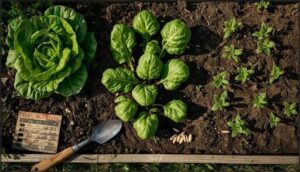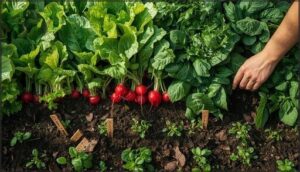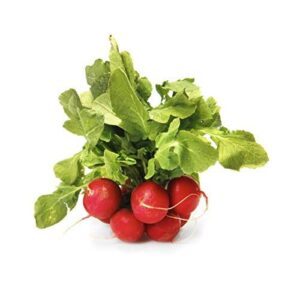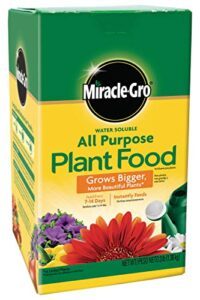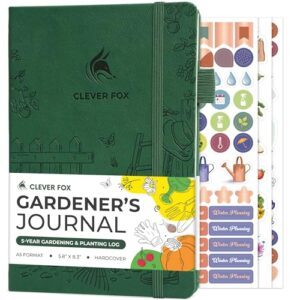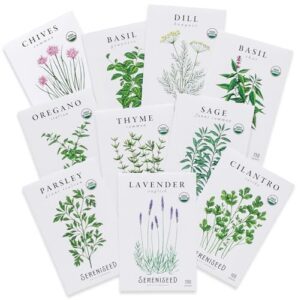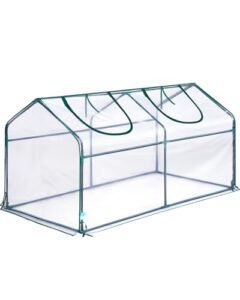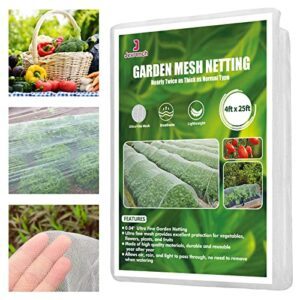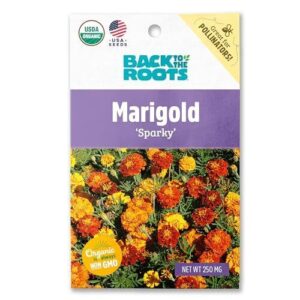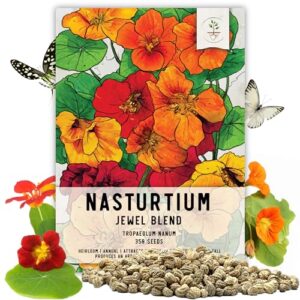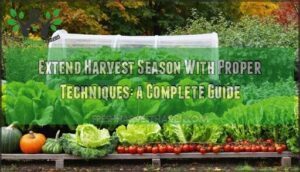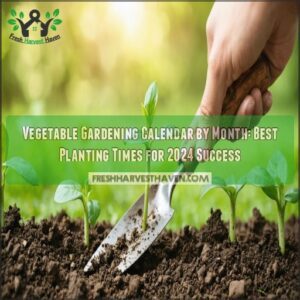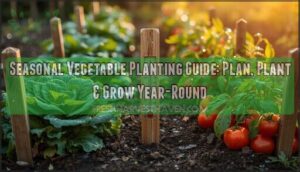This site is supported by our readers. We may earn a commission, at no cost to you, if you purchase through links.
Most spring gardens hit a wall by mid-May—beds that burst with lettuce and spinach in April sit empty by June, leaving you with nothing but weeds and regret. That gap between spring and summer harvests doesn’t have to exist.
When you extend spring harvest with succession planting, you transform those idle weeks into productive cycles that keep your kitchen stocked with fresh greens, crisp radishes, and tender peas for months instead of weeks.
The strategy isn’t complicated: plant small batches every 10-14 days, match crops to your frost dates, and replace finished plants immediately. You’ll boost yields by up to 50% per square foot while maintaining soil health through continuous rotation.
Master the timing, and you’ll turn a single harvest window into a rolling production line that bridges the hunger gap between seasons.
Table Of Contents
- Key Takeaways
- How Succession Planting Extends Spring Harvest
- Planning Your Spring Succession Planting Schedule
- Best Vegetables for Spring Succession Planting
- Succession Planting Techniques for Continuous Harvest
- Top 10 Products to Boost Spring Succession Planting
- 1. Root Radish Red Organic Fresh Bunch
- 2. Miracle Gro All Purpose Plant Food
- 3. Floral Desk Calendar Organizer
- 4. Clever Fox 5 Year Garden Journal
- 5. Sereniseed Organic Herb Seed Variety Pack
- 6. Portable Mini Greenhouse Kit Clear
- 7. Garden Plant Protection Netting Cover
- 8. Live Edible Herb Plant Assortment
- 9. Organic Marigold Sparky Seeds Packet
- 10. Jewel Mix Nasturtium Edible Flower Seeds
- Frequently Asked Questions (FAQs)
- How do you plant for a continuous harvest?
- How many days are there between successive plantings?
- What is the succession planting extension?
- When should I start succession planting?
- Does celosia need to be succession planted?
- How many days between succession planting?
- Do you succession plant in the same spot?
- How do you do succession planting?
- How to handle pest control during succession planting?
- What are the best tools for planting seeds?
- Conclusion
Key Takeaways
- You’ll eliminate the mid-season harvest gap by planting small batches of fast-maturing crops like lettuce, radishes, and peas every 10-14 days, turning a single harvest window into months of continuous production that can boost yields up to 50% per square foot.
- Success hinges on working backward from your last frost date to calculate maturity windows, then staggering sowings of cool-season crops throughout spring so you’re harvesting one batch while the next matures in the same bed.
- Strategic crop rotation between quick succession plantings maintains soil health and prevents pest buildup—replace finished lettuce with beans or follow spinach with beets to keep beds productive without depleting nutrients.
- The right tools make succession planting manageable: a detailed planting calendar tracks your staggered intervals, while season extenders like portable greenhouses and protective netting let you start earlier and harvest longer without chemical interventions.
How Succession Planting Extends Spring Harvest
Succession planting transforms your spring garden from a one-time harvest into a continuously productive space that feeds you for months instead of weeks. By staggering when you sow seeds and utilizing quick-growing crops, you’ll avoid the feast-or-famine cycle that plagues most vegetable gardens.
Let’s break down the core principles, benefits, and strategies that make this technique work so you can keep fresh produce coming from early spring right through summer.
Principles of Succession Planting
Succession planting transforms your spring garden through strategic timing and staggered planting intervals—usually every 7, 14, or 21 days. This method ensures continuous yields by aligning planting dates with maturity rates, turning one harvest window into multiple productive cycles throughout the season.
You’ll optimize space utilization by replacing cool-season crops as they finish, using crop rotation principles to maintain soil health. By implementing a soil health plan, gardeners can improve their overall garden ecosystem.
Benefits for Spring Vegetable Gardens
Beyond timing strategy, your spring vegetable gardens gain multiple advantages through succession planting. You’ll increase garden productivity by boosting yields up to 50% per square foot while optimizing space that would otherwise sit idle.
This approach maintains soil health through strategic crop rotation, preventing nutrient depletion. You’ll also extend harvest periods by 12+ weeks, maintaining fresh cool season crops from April through early July.
By implementing a succession planting strategy, gardeners can enjoy a continuous harvest of fresh vegetables.
Overcoming Seasonal Harvest Gaps
The dreaded ‘hunger gap’ between late winter and mid-spring can shrink by 1.5 months when you bridge seasons with overwintered crops like parsnips and leeks.
Succession planting addresses crop failure through strategic timing—staggered sowings prevent maturity gluts where everything ripens within five days.
You’ll master climate adaptation by rotating cool season crops into warm season spaces, extending your harvest window and optimizing soil management through continuous production cycles.
Planning Your Spring Succession Planting Schedule
The key to successful succession planting lies in building a schedule that matches your garden’s rhythm with nature’s timeline. You’ll need to know when it’s safe to plant, how long each crop takes to mature, and how your local weather patterns affect growth.
Let’s walk through the three essential steps to create a planting calendar that keeps your spring harvest rolling in week after week.
Determining Last Frost and Maturity Dates
You can’t plant with confidence until you know your last frost date. Most U.S. locations see their final frost between March 1 and May 15, though this varies by USDA Hardiness Zone and elevation.
Calculate maturity dates by working backward from your frost date—lettuce matures in 25–50 days, while carrots need 60–90.
Climate trends show springs arriving earlier, so track local patterns for accurate harvest scheduling with cool season crops.
Creating a Staggered Planting Calendar
With your last frost date in hand, map out your garden’s potential. Start by dividing your growing season into planting intervals—every two to three weeks for leafy greens, every 10–14 days for radishes.
Digital or printable calendars help you track seed scheduling and harvest windows, keeping your succession planting on target. This staggered approach transforms a single bed into three separate harvests.
Adjusting for Local Climate and Conditions
Your climate zone directly shapes your gardening strategy. Soil temperature matters more than calendar dates—warm soil through mulches or season extenders to plant cool season crops earlier. Frost dates provide the framework, but microclimates within your garden create hidden opportunities.
South-facing beds or sheltered corners let you push boundaries. Study local weather patterns, then adjust your succession planting intervals to match what your specific conditions allow.
Best Vegetables for Spring Succession Planting
Not every vegetable fits the rapid-fire rhythm of succession planting. You’ll get the best results from crops that mature quickly, tolerate replanting stress, and don’t demand long stretches of perfect weather.
Let’s look at the varieties that turn your spring garden into a non-stop harvest machine.
Fast-Growing Leafy Greens (Lettuce, Spinach, Arugula)
You’ll hit the ground running with leafy greens like lettuce, spinach, and arugula—three of succession planting’s all-stars. These varieties mature in just 25 to 40 days, letting you replant every week or two for a steady spring harvest.
Soil temperature management between 55°F and 70°F keeps germination quick, while proper garden bed preparation with compost ensures each planting thrives without skipping a beat.
Quick-Maturing Root Crops (Radishes, Carrots, Beets)
Root vegetables like radishes, carrots, and beets thrive with succession planting, delivering multiple spring harvests from the same bed. Direct sowing every 7 to 21 days prevents harvest gluts while extending your supply into late spring.
- Radishes: Mature in 25–30 days; sow every week for continuous harvests
- Carrots: Need 65–75 days; plant every 2–3 weeks for staggered yields
- Beets: Ready in 50–70 days at ideal 1.5–2 inch diameter
Proper soil preparation and harvest timing keep roots tender and flavorful through crop rotation cycles.
Productive Legumes (Peas, Green Beans)
Peas and green beans are succession planting powerhouses, rewarding you with 6–10 additional weeks of crisp harvests when you sow every 14–21 days. Start peas as soon as the soil can be worked, then follow with green beans once temperatures hit 55–60°F—your timing unlocks continuous picking from June through September.
| Crop | Maturity | Succession Interval | Total Harvest Extension |
|---|---|---|---|
| Bush Green Beans | 50–60 days | 15–21 days | 6–10 weeks |
| Pole Beans | 60–70 days | 21–28 days | 8–12 weeks |
| Garden Peas | 55–65 days | 14–21 days | 6–8 weeks |
Space bush green beans 2 inches apart in rows 18 inches wide, maximizing yield per square foot while supporting healthy crop rotation. Pick pods three times weekly before they oversize—continuous harvesting signals plants to produce more beans, pushing your total usable harvest up by 35% compared to single sowings. Six strategic plantings distribute harvest dates across 100 days, eliminating glut periods and waste while keeping your table stocked with tender legumes all season long.
Space beans 2 inches apart, harvest thrice weekly, and six staggered plantings will boost your yield 35% across 100 days
Early Summer Transition Crops (Squash, Cucumbers)
Summer squash and cucumbers bridge your spring greens to peak summer harvests—start sowings 6–8 weeks before your first frost, then repeat every 2–3 weeks to capture 16 weeks of continuous production while sidestepping pest surges.
- Direct-seed zucchini and yellow squash 45 days before warm weather peaks
- Protect cucumbers with row covers during early sowings to block beetles
- Schedule four successive plantings from late spring into midsummer
- Harvest promptly to signal plants for extended fruit set
Succession Planting Techniques for Continuous Harvest
Turning succession planting from concept to continuous harvest comes down to mastering a few practical techniques. The methods you choose—whether you’re sowing seeds directly or starting transplants, timing your plantings in waves, or maximizing every inch of garden space—will determine how smoothly your spring crops flow into early summer.
Here’s how to implement each approach for steady production.
Direct Sowing Vs. Transplanting
When you’re mapping out your succession planting schedule, choosing between direct sowing and transplanting dramatically impacts your crop establishment timeline and labor costs. Direct sowing lets you skip transplant shock entirely—seeds hit the ground, germination kicks in, and seedlings develop where they’ll mature. Root crops like carrots and radishes thrive this way.
Transplanting, however, gives you a head start on soil preparation and delivers earlier harvests despite higher initial effort.
Staggered and Relay Planting Methods
Staggered plantings deliver precision control over harvest timing—sow lettuce every 7 to 14 days and you’ll pull crisp greens for two months straight instead of facing one overwhelming flush.
Relay planting takes it further: tuck turnips into fading pea beds or follow spinach with beets, letting residual soil nutrients fuel the next crop. This doubles your garden layout’s efficiency without expanding a single bed.
Interplanting for Space Optimization
Interplanting squeezes 19% more productivity from your garden space by pairing crops with complementary growth habits—vertical climbers like peas alongside low-spreading lettuce, or radishes tucked between slow-maturing cabbage rows.
This spatial arrangement fosters crop diversification while optimizing soil nutrients through companion planting.
Your continuous harvest becomes automatic as fast growers finish before neighbors need the room, turning every square foot into a production powerhouse.
Replanting After Early Crop Harvests
Once your early radishes or lettuce clear out, you’ve got a golden window—replant within two weeks to dodge a 20% yield drop and keep your succession planting momentum strong. Soil replenishment matters: most pros add organic fertilizer immediately, while a week’s rest cuts pest carryover by 18%.
Smart harvest scheduling and replanting strategies turn one bed into multiple harvests:
- Sow beans or cucumbers after spring greens for 10–15 extra pounds per 100 square feet
- Plant cool-season crops twice as deep in warmer soil to boost germination
- Rotate crop families between plantings to maximize yield and prevent disease buildup
This approach transforms interplanting gains into season-long productivity through deliberate replanting and soil care.
Top 10 Products to Boost Spring Succession Planting
The right tools and products can make succession planting far easier to manage and greatly more productive. From seed varieties bred for continuous harvests to organizational aids, each product fulfills a specific purpose in extending your spring harvest.
Here are ten products that will help you implement succession planting with confidence and precision.
1. Root Radish Red Organic Fresh Bunch
You’ll want quick-maturing crops to power your succession planting strategy this spring, and radishes deliver results in just 25 to 30 days.
This organic fresh produce bunch gives you crisp root vegetables packed with radish nutrition—only 9 calories per half-cup, plus 10% of your daily vitamin C.
Plant every 7-10 days for a continuous spring harvest through your vegetable gardening season.
The proven approach to garden planning means you’ll harvest fresh radishes while later plantings mature, keeping your planting schedule efficient and your table stocked.
Best For: Home gardeners and health-conscious cooks who want fresh, organic radishes for salads and snacks without waiting long for harvest.
- Matures incredibly fast at just 25-30 days, so you can harvest multiple times in one spring season with succession planting every week or two.
- Low-calorie nutrition powerhouse with only 9 calories per serving and 10% of your daily vitamin C, plus you’re getting organic produce free from chemicals.
- Crisp texture and bright color make them perfect for fresh eating, and the bunch comes with stems and leaves you can use in cooking or smoothies.
- Often arrives dirty with sand or mud stuck in the leaves, so you’ll need to wash them thoroughly multiple times before eating.
- Quality isn’t always consistent—some radishes turn out woody or overly spicy, especially the larger ones that look promising.
- Priced at $2.79 per bunch, they cost more than bagged radishes at regular grocery stores, which might add up if you eat them often.
2. Miracle Gro All Purpose Plant Food
Your succession planting schedule demands steady plant nutrition, and this water-soluble fertilizer delivers a 24-8-16 NPK ratio that feeds every 7-14 days without burning your crops. Each 5-pound container covers up to 2,000 square feet—plenty for multiple spring plantings of leafy greens and root vegetables.
The balanced nitrogen blend promotes quick uptake and sustained growth, so your staggered radish, lettuce, and bean plantings maintain peak productivity throughout the season.
Mix 1.5 tablespoons per 1.5 gallons and watch your succession garden thrive with visible soil enhancement and optimized crop performance.
Best For: Gardeners running succession plantings who need a reliable, fast-acting fertilizer that won’t burn crops when feeding every 1-2 weeks across multiple staggered sowings.
- 24-8-16 NPK formula with balanced nitrogen sources provides both immediate feeding and sustained nutrient release, perfect for keeping successive plantings of greens, roots, and beans growing strong throughout the season.
- Covers up to 2,000 square feet per 5-pound container with simple mixing (1.5 tbsp per 1.5 gallons), making it economical and easy to maintain a consistent feeding schedule across your entire garden.
- Water-soluble crystals with blue dye indicator let you see exactly where you’ve fed, preventing gaps or overlaps when managing multiple planting zones at different growth stages.
- Requires precise dilution and careful measurement every 7-14 days—overfeeding or direct crystal application can burn plants, adding extra steps to your routine.
- Synthetic formulation may contribute to soil salt buildup with frequent use, potentially requiring soil flushing or amendments over time.
- Not ideal for organic gardening systems, and some plant varieties may not respond well to the high nitrogen content or feeding frequency.
3. Floral Desk Calendar Organizer
Track your staggered sowings with a 21-month calendar that bridges April 2025 through December 2026, giving you the visual space management and desk organization needed for precision succession planting.
The 17″ x 12″ floral design transforms calendar planning into a productivity tool that maps warm season crops, cool season transitions, and harvest management across multiple planting windows.
You’ll schedule radish sowings every two weeks, plan lettuce relays, and coordinate year-round harvests with room for maturity dates and weather notes—turning complex succession timing into a glanceable roadmap.
Best For: Gardeners managing multiple succession plantings who need a large visual workspace to track staggered sowings, coordinate planting windows, and plan year-round harvests across different crop cycles.
- The 21-month span from April 2025 to December 2026 covers multiple growing seasons, letting you map out entire succession planting schedules without switching calendars mid-season.
- At 17″ x 12″, there’s plenty of room to note maturity dates, weather patterns, and specific sowing intervals for crops like radishes and lettuce without cramping your handwriting.
- The waterproof cover and durable 120 gsm paper protect your planting records from greenhouse moisture and garden bench spills.
- Some users struggle to tear off monthly pages cleanly, which could be frustrating when you want to archive completed planting cycles.
- The large size might overwhelm smaller potting benches or compact office desks where space is already tight.
- You’ll need to remove the clear protective sheet before writing, adding an extra step when you’re rushing to log a planting date.
4. Clever Fox 5 Year Garden Journal
Building multi-year records transforms your succession planting from guesswork into a science. The Clever Fox 5 Year Garden Journal delivers undated monthly sections with 120gsm paper that manages field notes across five planting seasons, tracking your radish intervals, lettuce relay timing, and harvest yields in one compact 5.8×8.3″ planner.
You’ll map garden beds, log frost patterns, and adjust staggered schedules using lay-flat binding that stays open during transplanting.
The eco-leather cover, elastic closure, and included zone maps turn seasonal gardening strategies into documented crop tracking that builds gardening productivity year after year.
Best For: Gardeners who want to track succession planting cycles, harvest patterns, and long-term garden performance across multiple growing seasons.
- Five years of undated tracking pages let you document staggered planting schedules, harvest windows, and crop rotations without rushing to fill it out by a specific date.
- Lay-flat binding and thick 120gsm paper handle field notes easily, while dedicated sections for pests, soil pH, and frost dates help you refine replanting timing each season.
- Compact size with durable eco-leather cover and elastic closure makes it practical to carry into the garden for real-time logging during planting and harvesting.
- Limited to five years means you’ll need a new journal once you’ve filled it, which may interrupt your long-term record keeping.
- Planting zone information and references are geared toward North American gardeners, so international users may need to adapt the content.
- Some gardeners may find the pre-designed layout restrictive if their tracking needs don’t match the journal’s specific sections and prompts.
5. Sereniseed Organic Herb Seed Variety Pack
Fresh herbs at your fingertips transform routine succession planting into a culinary adventure. The Sereniseed Organic Herb Seed Variety Pack delivers 10 USDA-certified organic varieties—parsley, basil, cilantro, thyme, dill, and five more—all stored in climate-controlled conditions for enhanced germination rates.
You’ll stagger quick-growing herbs like cilantro every two weeks alongside slower lavender and sage, filling gaps between vegetable rows with aromatic succession crops. Non-GMO, heirloom genetics and detailed planting instructions turn your spring garden planning into a harvest management system that feeds both dinner plates and long-term garden productivity.
Best For: Home gardeners and cooks who want to grow their own organic culinary herbs year-round, whether in containers indoors or garden beds outside.
- USDA certified organic, non-GMO heirloom seeds stored in climate-controlled conditions with germination guarantee and video guide included
- Quick germination (often within a week) and high success rates make these accessible even for beginners starting their first herb garden
- Ten versatile varieties from basic parsley and basil to specialty herbs like Thai basil and lavender give you plenty of culinary options
- Some customers report occasional low germination rates or seeds not being true to variety (like getting lemon basil instead of Genovese)
- Certain herbs like lavender require extra care and attention, which may challenge newer gardeners
- Performance depends heavily on your climate and growing conditions—not every variety thrives everywhere
6. Portable Mini Greenhouse Kit Clear
A 71″L x 36″W x 36″H compact shelter transforms your succession planting strategy into a year-round operation. This portable mini greenhouse with a clear PVC cover and powder-coated steel frame creates an ideal mini climate control for staggered sowings—you’ll start cool-season crops weeks earlier and extend harvests into late spring.
Roll-up vents prevent overheating, while the elevated design optimizes space for relay plantings. Season extension becomes seamless when rotating quick-maturing greens under controlled conditions, turning garden planning into a continuous harvest cycle that conforms to your crop rotation schedule.
Best For: Gardeners who want to extend their growing season with succession planting, especially those with limited space who need a portable solution for starting seeds early and protecting tender plants from frost.
- Increases plant growth rate by 30% with high light transmission through the clear PVC cover, plus roll-up vents give you control over temperature and humidity
- Elevated design and 71″L x 36″W x 36″H dimensions provide plenty of room for staggered sowings and relay plantings without taking up your entire yard
- Easy to set up and move around to catch the best sunlight, plus it comes with 50 plant tags to keep your succession plantings organized
- Lightweight design means you’ll need to weight it down or use extra clips to keep it secure in windy conditions
- The PVC cover can tear or wear out within 1-2 seasons, especially with regular use and weather exposure
- Steel frame may rust quickly if exposed to moisture, requiring maintenance or eventual replacement of components
7. Garden Plant Protection Netting Cover
Protecting your staggered plantings from birds, insects, and mammals becomes non-negotiable as you expand garden space through succession planting. Ultra-fine 0.8mm protective mesh in a 4ft x 25ft roll creates effective crop shields that reduce insect damage by up to 89% while maintaining 85% light transmission—your plants breathe, rain penetrates, and photosynthesis continues uninterrupted.
This reusable netting materials solution lasts 3-5 seasons, cutting pesticide use by 80% during season extension windows. Anchor garden covers firmly over relay sowings to exclude carrot flies and cabbage butterflies while supporting healthier crop rotation practices throughout garden maintenance cycles.
Best For: Gardeners using succession planting or crop rotation who want to protect multiple plantings from pests without relying on chemical sprays.
- Cuts insect damage by up to 89% while letting 85% of sunlight through, so plants stay healthy and rain can still reach them naturally
- Lasts 3-5 growing seasons and reduces pesticide use by 80%, saving money and supporting organic gardening practices
- Large 4ft x 25ft size can be cut to fit different bed layouts, making it versatile for protecting staggered plantings throughout the season
- Needs to be anchored securely since wind can lift it easily, and it may not hold up well in very windy locations
- Some users report the material rips or frays more easily than expected, especially when using clips or stakes that can create weak points
- Can be hard to see through in bright sunlight, making it trickier to check on plants without lifting the netting
8. Live Edible Herb Plant Assortment
While seasonal vegetables dominate your succession schedule, live edible herb plant assortments offer year-round versatility that complements every planting cycle. A six-pack collection—including lemon verbena, eucalyptus, mint, and lemon balm—arrives fully rooted, ready for immediate placement between relay plantings.
These indoor gardening essentials mature faster than most vegetables, filling gaps in your harvest management and planning strategy. Plant them in partial sun alongside spring greens, then relocate containers indoors as temperatures shift, maintaining continuous culinary harvests that extend well beyond traditional growing windows.
Best For: Home gardeners who want fresh herbs year-round without waiting for seeds to sprout, especially those managing succession plantings or looking to fill gaps between seasonal crops.
- Arrive fully rooted and ready to plant, so you can skip the germination phase and start harvesting within weeks
- Work indoors or outdoors depending on the season, giving you flexibility to move them as temperatures change
- Include versatile varieties like mint and lemon balm that regrow after cutting, providing multiple harvests from a single plant
- May show some shipping stress or damage when they arrive, requiring a few days of recovery before they look their best
- The exact herb varieties can vary based on what’s available at the greenhouse, so you might not get the specific mix you’re expecting
- Need consistent attention to watering and light conditions—overwatering or pest issues like mites can set them back if you’re not careful
9. Organic Marigold Sparky Seeds Packet
If you’re aiming for maximum garden productivity, don’t overlook the Organic Marigold Sparky Seeds packet. Marigold benefits go far beyond color—these blooms attract pollinators, repel pests, and boost soil health, all while fitting seamlessly into succession planting strategies.
With reliable seed germination and fast growth, they’re a smart choice for organic gardening and harvest management and planning. Interplant them with your vegetables for natural pest control and nutrient cycling—one of the best vegetable gardening tips for extending your spring harvest.
Best For: Gardeners who want easy, colorful blooms that help pollinators and naturally keep pests away, whether you’re a beginner or seasoned grower.
- Attracts pollinators and repels common garden pests naturally
- Thrives in tough conditions and needs little maintenance
- Improves soil health and works well as a companion plant
- Some packets may have lower germination rates
- Needs deadheading for continuous blooms
- Not suitable for every climate or growing zone
10. Jewel Mix Nasturtium Edible Flower Seeds
Beyond marigolds, Jewel Mix Nasturtium seeds deliver edible landscaping that works double-duty in succession planting. With seed germination in 7–14 days and maturity at 54–65 days, you’ll harvest peppery flowers packed with vitamin C while practicing companion planting—they trap aphids away from cucumbers and squash.
Plant every two weeks for continuous blooms, perfect for nasturtium recipes or garden productivity tips. Their drought tolerance aids sustainable gardening practices, and interplanting them between rows maximizes space.
For flower care and crop rotation and management, these nasturtiums are pure gardening tips gold.
Best For: Gardeners who want edible flowers that do double-duty—adding peppery flavor to meals while naturally repelling pests from vegetable gardens.
- Fully edible with impressive nutrition—130 mg of vitamin C per 100g and high lutein content rivals many superfoods
- Fast results with germination in 7–14 days and blooms ready to harvest in under 10 weeks
- Low-maintenance companion plant that attracts pollinators and traps aphids away from your vegetables
- Some buyers report inconsistent germination rates, especially if seeds are oversoaked before planting
- Won’t bloom well in extreme heat or cold, limiting growing windows in harsh climates
- Needs consistent moisture and good drainage—neglecting either can stunt growth or cause rot
Frequently Asked Questions (FAQs)
How do you plant for a continuous harvest?
You plant for a continuous harvest through succession planting—sowing crops at 7-to-21-day intervals using staggered plantings.
This garden planning technique combines smart seed selection with harvest scheduling, ensuring your beds stay productive through strategic crop rotation and soil management.
How many days are there between successive plantings?
Most quick-maturing spring crops follow planting intervals of 7 to 14 days. Leafy greens thrive on weekly succession schedules, while root vegetables like beets prefer 14-day harvest spacing to maintain steady growth periods.
What is the succession planting extension?
Succession planting extension involves staggering crop rotation and harvest scheduling throughout your growing season. This garden planning strategy facilitates year-round harvests by replanting as crops mature, optimizing yield through soil management and seasonal planting intervals that extend harvest periods continuously.
When should I start succession planting?
You can begin after your last spring frost date. Start cool-season crops like lettuce and spinach when soil is workable, then add warm-season varieties. Frost date planning ensures proper seed selection and timing for your climate.
Does celosia need to be succession planted?
Celosia won’t survive on neglect alone. For continuous celosia bloom and peak flower production, succession sowing every three weeks through summer keeps your garden planning sharp, planting intervals tight, and harvest management steady—extending blooms beyond six weeks.
How many days between succession planting?
Most gardeners space succession planting intervals between 7 and 14 days, depending on crop type. Fast-maturing crops like radishes need shorter gaps, while beans and peas thrive with 10-14 day staggering plantings.
Do you succession plant in the same spot?
You can succession plant in the same spot, but crop rotation and diversity protect soil health.
Alternating plant families prevents pest buildup and nutrient depletion, keeping your garden bed management sustainable while maximizing space optimization through smart succession schedules.
How do you do succession planting?
You plant crops at staggered intervals—every 1-4 weeks—using direct sowing or transplants. Track maturity dates and practice crop rotation to maintain soil health. Utilize interplanting vegetables for maximizing garden space while extending harvest periods continuously.
How to handle pest control during succession planting?
Combine trap cropping with companion planting to reduce pest damage by up to 30%. Rotate crops strategically, use resistant varieties, and time plantings to avoid peak pest activity—these integrated strategies protect your continuous harvests naturally.
What are the best tools for planting seeds?
Your planting arsenal should include hand seeders for precision sowing, push seeders for larger areas, and traditional dibbers or trowels for small-scale work.
These garden tools dramatically reduce labor while improving seed spacing accuracy.
Conclusion
Your garden doesn’t need to go dormant while you wait for tomatoes to ripen. Extend spring harvest with succession planting, and those “slow weeks” between seasons disappear—replaced by steady yields that keep your pantry full and your beds productive.
Start with one crop, nail the rhythm, and scale up as confidence builds. The gap between spring and summer isn’t inevitable; it’s just untapped potential waiting for your next planting date.
- https://extension.wvu.edu/lawn-gardening-pests/news/2019/01/15/basics-of-succession-planting
- https://fieldreport.caes.uga.edu/succession-planting-for-an-extended-harvest/
- https://www.epicgardening.com/succession-plant-crops/
- https://attra.ncat.org/publication/scheduling-vegetable-plantings-for-continuous-harvest/
- https://www.sierraflowerfarm.com/blog/advanced-crop-planning-succession-rotation-and-tracking-systems



